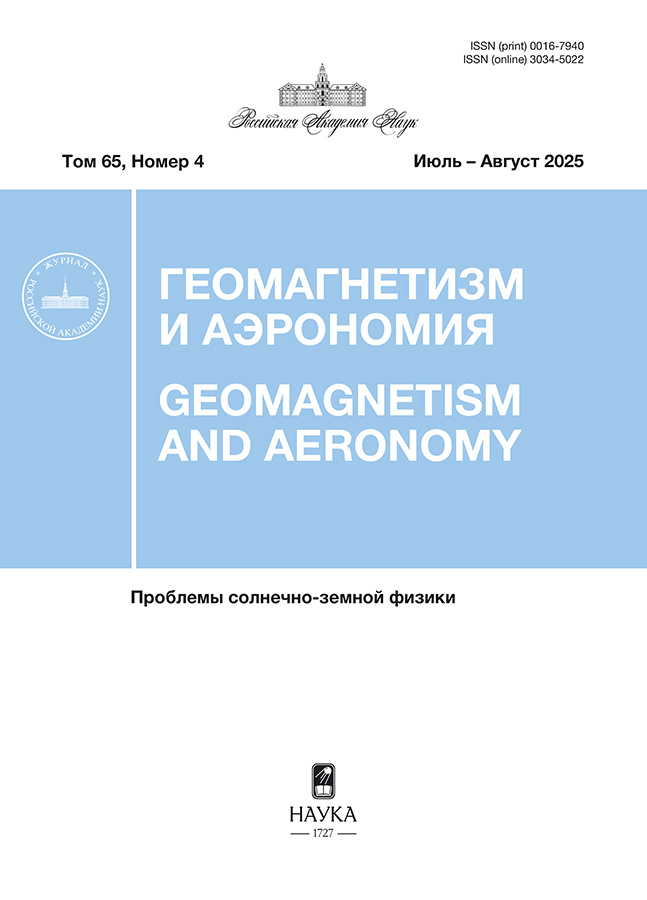Some features of the evolution of the magnetic complex of activity including AO NOAA 11944 and NOAA 11946, during its passage across the solar disk
- 作者: Zagainova Y.S.1, Obridko V.N.1, Fainshtein V.G.2, Rudenko G.V.2
-
隶属关系:
- Pushkov Institute of Terrestrial Magnetism, Ionosphere, and Radio Wave Propagation of the Russian Academy of Sciences (IZMIRAN)
- Institute of Solar–Terrestrial Physics, SB of RAS
- 期: 卷 65, 编号 4 (2025)
- 页面: 430-436
- 栏目: Articles
- URL: https://bioethicsjournal.ru/0016-7940/article/view/688289
- DOI: https://doi.org/10.31857/S0016794025040022
- EDN: https://elibrary.ru/EXGRWV
- ID: 688289
如何引用文章
详细
The evolution of properties of the magnetic activity complex (MAC) during its passage across the solar disk on (03–12).01.2014 was analyzed. This MAC comprises two active regions (ARs) magnetically coupled by the equator, that are located in different solar hemispheres: AR NOAA 11944 in the Southern Hemisphere and NOAA 11946 in the Northern Hemisphere. Time dependences of total unsigned magnetic fluxes of all spots, including pores, and specifically for each polarity were plotted for each AR. The variation of total unsigned magnetic flux F(t) for all MAC sunspots was examined with respect to the variation of total area of the corresponding sunspots S(t). In all cases, the magnetic flux increases non-monotonically, reaches its maximum, and decreases afterwards. We found differences in the pattern of changes in F(t) and S(t) during the period 10.01–12.01, which are related to the characteristics of radiation bursts in the hard X-ray range and solar flares in soft X-ray range. No halo-type coronal mass ejections were detected in the MAC during the entire observation period, and relatively few limb CMEs were detected when the MAC was close to limbs.
全文:
作者简介
Yu. Zagainova
Pushkov Institute of Terrestrial Magnetism, Ionosphere, and Radio Wave Propagation of the Russian Academy of Sciences (IZMIRAN)
编辑信件的主要联系方式.
Email: yuliazag@izmiran.ru
俄罗斯联邦, Troitsk, Moscow
V. Obridko
Pushkov Institute of Terrestrial Magnetism, Ionosphere, and Radio Wave Propagation of the Russian Academy of Sciences (IZMIRAN)
Email: yuliazag@izmiran.ru
俄罗斯联邦, Troitsk, Moscow
V. Fainshtein
Institute of Solar–Terrestrial Physics, SB of RAS
Email: yuliazag@izmiran.ru
俄罗斯联邦, Irkutsk
G. Rudenko
Institute of Solar–Terrestrial Physics, SB of RAS
Email: yuliazag@izmiran.ru
俄罗斯联邦, Irkutsk
参考
- Загайнова Ю.С., Файнштейн В.Г., Обридко В.Н., Руденко Г.В. Исследование магнитных свойств тени солнечных пятен // Астрономический журнал. Т. 99. № 2. C. 100–150. 2022. https://doi.org/10.31857/S0004629922030069
- Обридко В.Н. Солнечные пятна и комплексы активности. М.: Наука, 256 с. 1985.
- Обридко В.Н., Шельтинг Б.Д. Глобальные комплексы солнечной активности // Астрономический журнал. Т. 90. № 10. С. 857–868. 2013. https://doi.org/10.7868/S0004629913100046
- Язев С.А. Комплексы активности на Солнце в 24-м цикле солнечной активности // Астрономический журнал. Т. 92. № 3. С. 260–269. 2015. https://doi.org/10.7868/S000462991503007X
- Ishkov V.N. Complex active regions as the main source of extreme and large solar proton events // Geomagn. Aeronomy. V. 53. N 8. P. 971–976. 2013. https://doi.org/10.1134/S0016793213080070
- Rudenko G.V. Extrapolation of the solar magnetic field within the potential-field approximation from full-disk magnetograms // Solar Phys. V. 198. № 1. P. 5–30. 2001. https://doi.org/10.1023/A:1005270431628
- Rudenko G.V., Anfinogentov S.A. Very fast and accurate azimuth disambiguation of vector magnetograms // Solar Phys. V. 289. № 5. P. 1499–1516. 2014. https://doi.org/10.1007/s11207-013-0437-y
- Yazev S.A., E.S. Complexes of activity on the Sun in solar cycle 21 // Solar-Terrestrial Physics. V. 7. № 4. P. 3–9. 2022a. https://doi.org/10.12737/stp-74202101
- Yazev S.A., Isaeva E.S. Activity сomplexes and сoronal holes on the Sun: Relationship phenomenology // Astron. Rep. V. 66. № 11. P. 1050–1062. 2022b. https://doi.org/10.1134/S1063772922100134
- Yazev S., Isaeva E. Activity complexes on the Sun in cycle 24 / Astronomy at the Epoch of Multimessenger Studies / Proc. VAK-2021 conference. Moscow, August 23–28, 2021. / Eds. A.M. Cherepashchuk et al. M.: Janus-K. P. 343. 2022c. https://doi.org/10.51194/VAK2021.2022.1.1.136
- Zagainova Yu.S., Fainshtein V.G. Effect of explosive processes on the Sun on the inclination angles of the magnetic field lines in the sunspot umbra // Geomagn. Aeronomy. V. 61. № 7. P. 928–936. 2021. https://doi.org/10.1134/S0016793221070240
- Zagainova Yu.S., Fainshtein V.G. Study of the magnetic properties of sunspots in active regions with explosive processes // Geomagn. Aeronomy. V. 62. № 8. P. 1034–1044. 2022. https://doi.org/10.1134/S0016793222080242
补充文件











